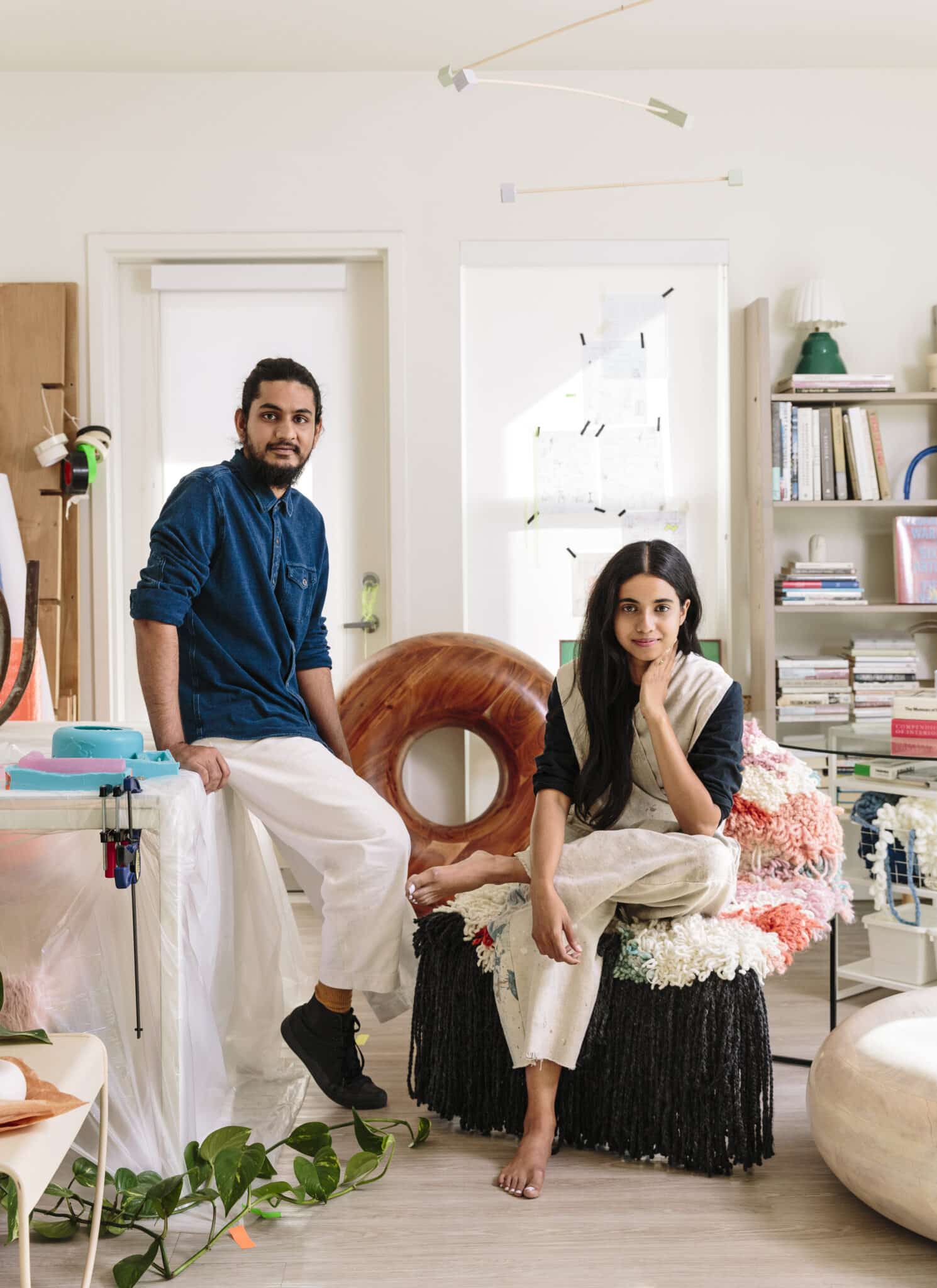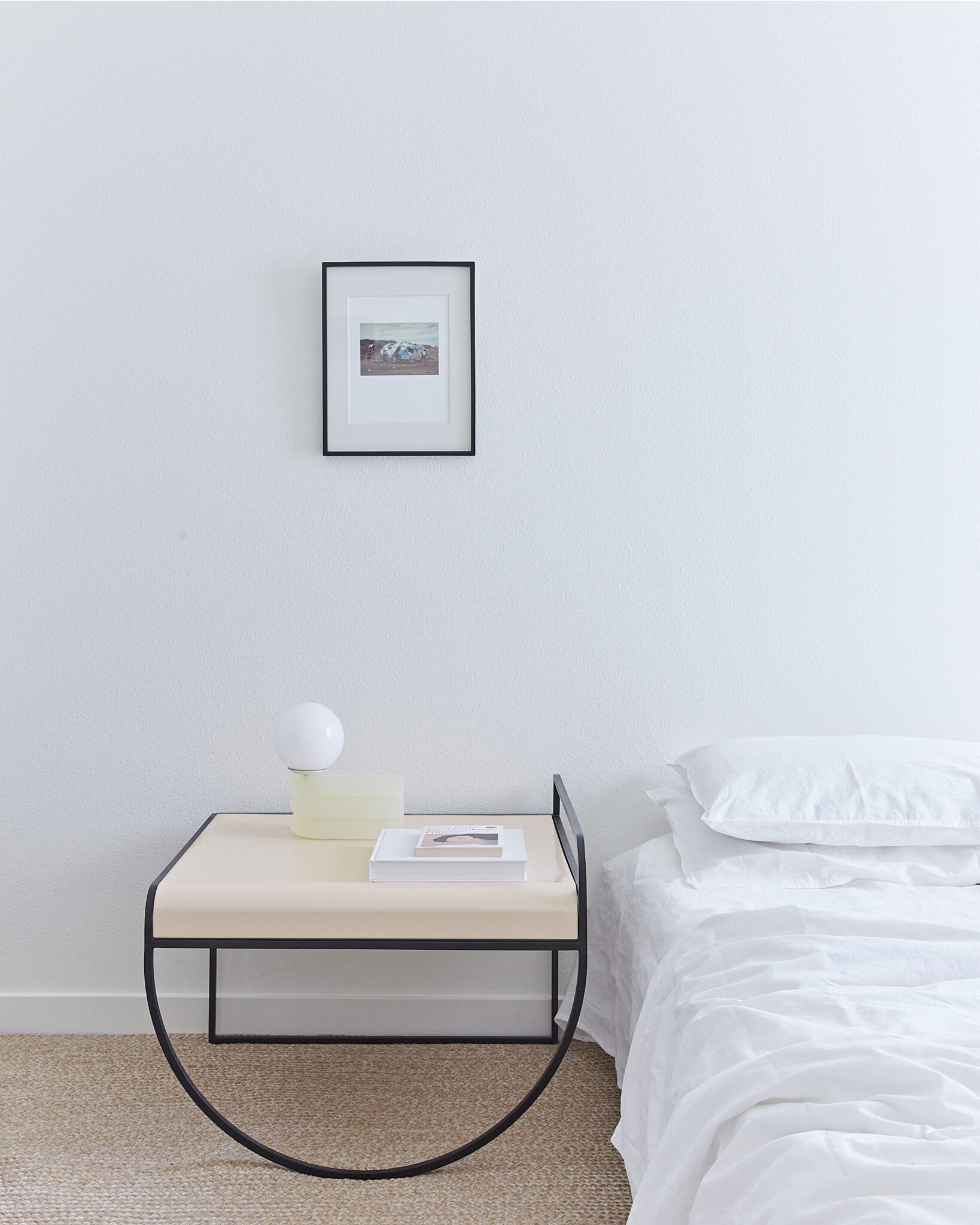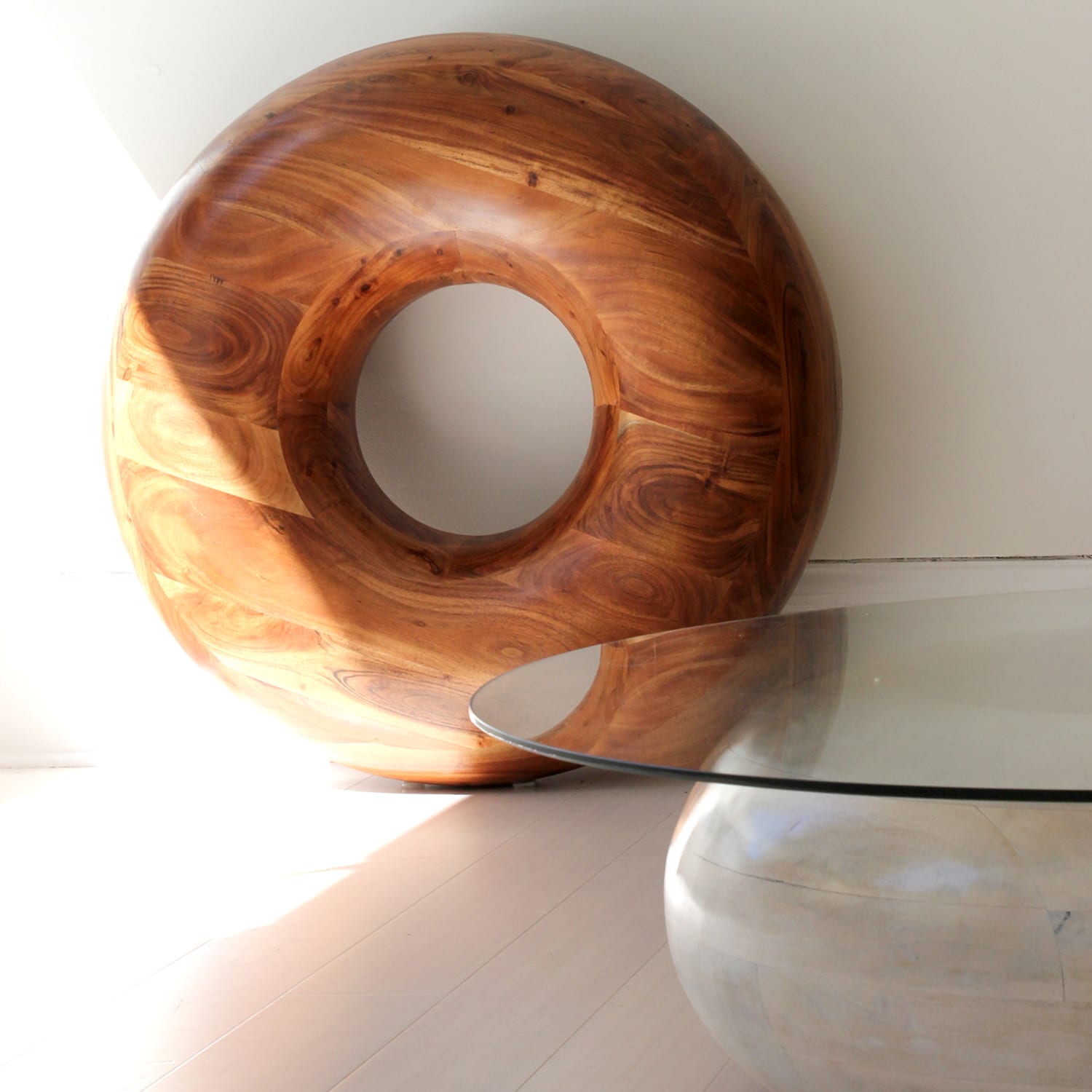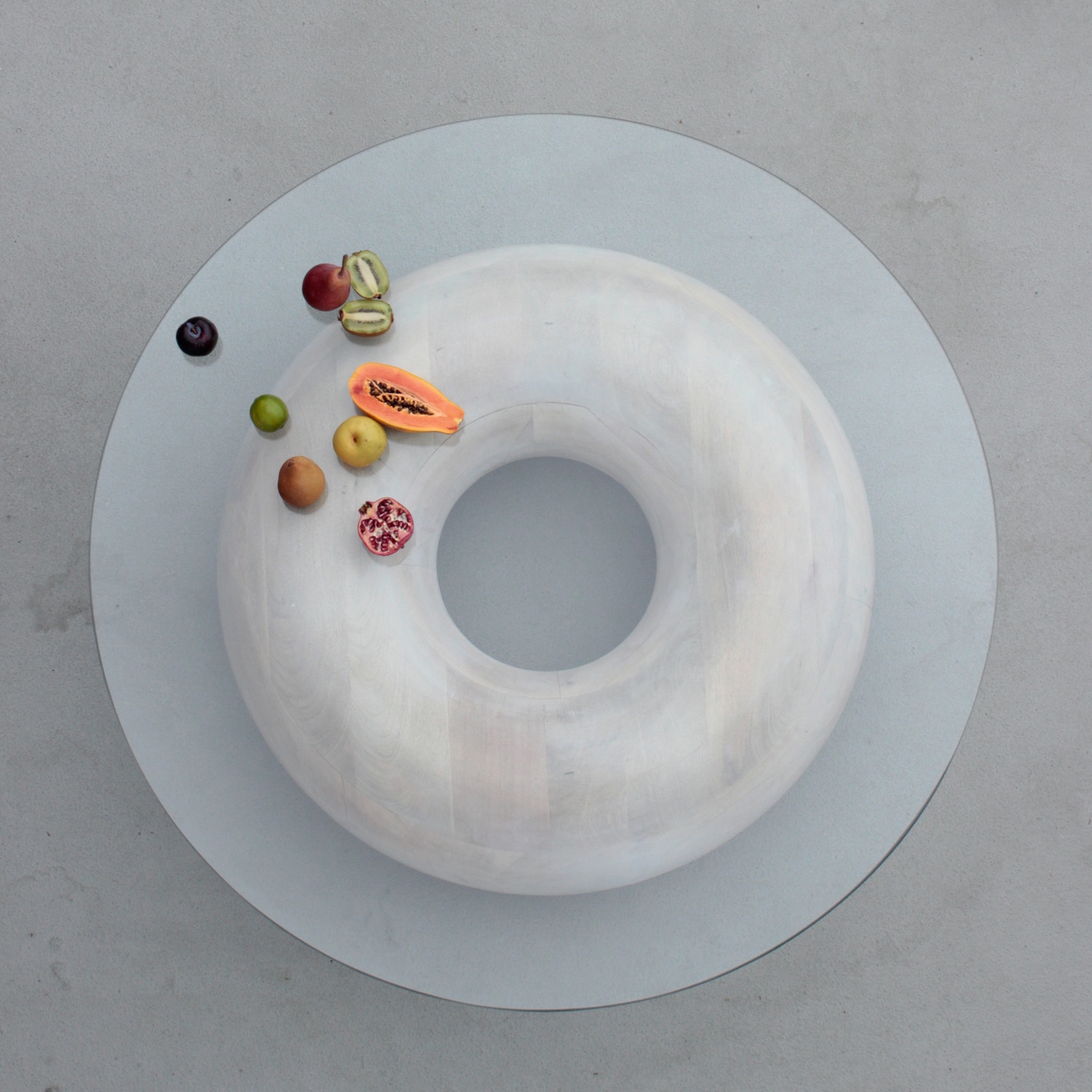
Soft-Geometry
1. Where were you born and where are you from ?
Utharaa: Palaash is from Ghaziabad, near New Delhi and I am from Kochi, Kerala on the south west coast of India. It’d be hard to pick two places more diametrically opposite in every way. On either end of the country with different cultures and geographies; we speak different languages, eat different foods, were brought up in different religions and follow completely different traditions.
2. What is your first memory connected to the art world ?
Utharaa: Growing up in small towns in India, we rarely had formal exposure to art. What we did have was an abundance of craft. Crafts and craftspeople were all around us. Even the most utilitarian objects in our homes were are hand-made, sculptural and beautiful – step stools in bamboo with a distinct color pattern, block-printed bedding, hammered brass lottas, hand-carved jewellery boxes, handloom cotton clothes, and endless terracotta pottery. Everything was treated as a canvas for artistry, everything was sculpture, so being submerged in that culture – those were our formative memories – perhaps not of art – but certainly of craft, expression and beauty.
3. Have you always worked in the art/design field ?
Palaash: Yes, we were lucky enough to find each other when we were both 19 in design school, and were propelled to collaborate ever since. Our dialogue and exchange was and continues to interest and inspire new work and hopefully always will, and that is what has kept us steadfast in our creative field.
4. What led you to the design creation ?
Palaash: I had kind of a destructive streak as a child, I pulled things apart constantly, toys, watches, bikes, just about anything I could get my hands on. Predictably I got into trouble for it and I’d have to put it back together and fix it. I didn’t think much about it then, but clearly I enjoyed this process and when I had to decide what I wanted to do for college, I figured it would be cool to learn how things are built. I wasn’t even very aware of ‘design’, I only knew that I liked pulling things apart and figuring out how they went back together again. When I started college for product design, I just kept wanting more and more of it.
Utharaa: My parents were architects. When I grew up in Kochi, I often felt like the only kid in class who genuinely believed her parents had cool jobs. They had separate architecture and design practices, with slightly different philosophies and vastly different projects. My sisters and I grew up consumed by it, – the after-school trips to construction sites, the waiting in their offices as they finished a presentation and the pride of being in spaces created by them. Very often we would accompany my mom as she went late at night to finish up a site, staged and ready for a move in or inauguration the next day. There would always be a lot left to do, but she would have this kind of infectious positive energy that had everyone on her team pumped up and finishing things off a checklist. She’d let us help too – I’ve cleaned mirrors, made beds, fluffed pillows, arranged flowers and even laid tiles once! That was what led me to design, my parents and their love for what they do.
What is true for both of us though, is that the kind of designers we are now and the intentions and dreams we have today, are a result of our meeting each other.
5. How would you describe your creative process and it influences ?
Utharaa: We try, obsessively, to understand ‘softness’. Softness is a degree, almost anything can be plotted along a soft-hard axis. It is our perpetual design exercise to toss between each other ideas of what makes an object soft. Material and the tactile is a given – soft velvet, fur, felt, hair, wool and any other number of materials that are soft to touch. There are visual associations – pastel colors, billowy clouds, things that lack edges, the soft light of dawn or dusk. You can also plot sounds – soft whispers, soft melodies, the rustle of leaves; or scents – the smell of rain, wet ground or faint perfume. More interestingly still, you can think of it in the abstract – softness as malleability, a willingness to learn or change, fluidity, humility, empathy, slowness, childlike innocence or imperfection.
Increasingly we make connections between these ideas and Indian object culture that we grew up in, our childhood homes filled with a mish mash of objects, cane step stools, carved wood boxes, inlaid trays, block printed linens, hammered brass lottas – things that did not match or stack, weren’t modular or multi-functional, belong to a style or palette, but shared that they were hand-made. Objects built by hand, woven by hand, considered and crafted by hand imparts softness.
Whether it is the soft light that shone through dusty panes that inspired the Elio lamps or the slow craft of caning that inspired the woven chairs and tables of the sw collection – softness and Indian culture inspires and informs our work and life everyday.
6. Could you describe a typical day of your work ?
Palaash: We can be chaotic in the way we work. We usually start with solving something – something that needs to be figured out for that day – it could be big or small, like forgetting to correct the price on something or filling out some paperwork somewhere, but there is always something and we start off by fixing that. Once we get past that, we go into packing and shipping orders that need to go out for the day. Then to on hand orders and correspondence. On a good day we finish all this grown-up stuff by lunch and the afternoons are for new ideas and for tinkering with prototypes, long conversations, scouring finishes/fabrics or sketches. We always end the day with an hour-long walk, although it is quite normal that the day stretches on even after, because somehow there is always a deadline.
7. Why did you choose the specific materials you work with ?
Palaash: We think of materials in objects, as clothes are to the body, and so we don’t have a fixed material palette – we just keep adding new ones to the mix, each driven by different contexts and exploring different notions of softness. Since starting soft geometry about 2 and half years ago, we have worked with steel, upholstery, handwoven yarn, handwoven cane, acrylic, repurposed solid wood, faux fur, fabric waste and cast resins. We often have the same product dressed in different materials to offer and illustrate different object personalities.
As we go forward, we’re looking to add more materials, especially new sustainable materials to our folio. We want our material palette to be expansive, experimental and creative, never limited.


8. What are the technical particularities of your creations ?
Palaash: Perhaps the most technical of our work that generally leans more handmade, is the Donut Coffee Table. The piece is centered around a sustainable use for wood waste and
started when an export furniture factory from India reached out to us regarding their solid wood cut-offs. Primarily supplying furniture to American retailers, they have to follow a stringent selection process for wood boards. Any board that carries knots or unusual grain patterns have to be rejected. This process of elimination accumulates vast quantities of wood cut-offs that are now waste. Both of us, like many Indians, grew up within strict instructions to never waste anything – not a grain of rice nor the last inch of a pencil. We can still hear our parents’ voices saying exactly those things and that became the context for the brief.
We worked closely with the factory on studying and categorizing all of the different sizes of wood cut-offs. What was both beautiful and challenging was that there was little uniformity between them. We decided the piece needed to be sculptural, something that can take on these different sizes and celebrate instead of discarding it’s “flaws” and thus arrived at the Donut.
The seemingly simple form of the Donut and its circular cross-section allowed us to design a system of arranging the wood boards that made all these weird sizes come together, and then be carved on a CNC. Since the process of arranging the boards is on a grid format but the final form is rounded – we cannot pre-guess the wood grain – we only see the grain after the piece comes out of the CNC – which makes every piece unique and allows little room for waste. Any pieces that came off the carving can again be used in the next donut. It was very satisfying to arrive at an object that is so beautiful and very us, using waste material.
9. What advices could you give to beginning artists who would like to create sculptural design works ?
Palaash: to get started. There is often tendency to wait for something, be it time, opportunity, space, tools, funds – stop waiting, start building, with whatever resources you have right now. Everything else will follow. We try to put this into practice everyday, almost everything we’ve made was born of far from ideal settings.
10. If your works had to belong to a design movement, in which one would you define it ?
Utharaa: Perhaps as an intersection of the Bauhaus, the Memphis and the Indian arts & crafts?
11. What designers have influenced you ?
Utharaa: Shiro Kuramata, Eileen Gray, BV Doshi, Gaetano Pesce, Noguchi, Sotsass, Pierre Jeanneret…to skim the top of our lists.
12. What contemporary designers do you appreciate ?
Palaash: We don’t usually agree on a favorite, but right now Yeon Jinyoung from Seoul is at the top of both of our lists! His work is simply brilliant – fun, diverse, experimental and inimitable style.
One of the best things to happen last year at the helm of the pandemic, is that we were able to round up 10 of our favorite contemporaries in design from all over the world, including Yiang and organized an imaginary exhibit called “Imagined, for uncertain times”. The roster also included Serban Ionescu, Mark Grattan of Vidivixi, Leah Mestres, Laurids Gallee, Merle Flugge & Job Muowen of Supertoys -Supertoys, Benjamin Gillespie of Ovuud, Supertoys-Supertoys and Ryan EImear of Argot studio – all of whom are fantastic and inspiring contemporaries.
13. What contemporary artists (in any kind of art) have you been inspired by ?
Utharaa: We discovered the photography of Berlin based Ole Witt, last year through a print exhibition. His series titled Random Acts of Administration, captures a rarely seen facet of Indian-ness. It reminded us of a uniquely Indian spirit and mindset, which was both inspiring and relatable.
Another exciting introduction was to the work of sculptor Ann Weber, who’s cardboard sculpture we encountered at a friend’s home. The volumes, intricacy and form captured using the most humble of materials was awe inspiring.
14. If you had to summarize your creations in one word or sentence, what would it be ?
Utharaa: “soft-geometry!”
Everything we design is expressive of us and ‘soft’ is how we would describe us- our personalities – if that makes sense!. As an extension of that, soft is what we aspire to in our products, our work, and everything we touch. We think of softness as slowness, intimacy, humor, humility, kindness and a quiet sort of courage and strength to be different and true, even if it is sometimes awkward or strange.
It may be hard to view all of this in objects, but the hope is that you still feel it, a softness within geometries, hence the name.
Proust Questionnaire with very short answers (one or a few words) :
(The Proust Questionnaire is a set of questions answered by the French writer Marcel Proust. Other historical figures who have answered confession albums are Oscar Wilde, Karl Marx, Arthur Conan Doyle, Stéphane Mallarmé, Paul Cézanne…)
1. What is your idea of perfect happiness?
U : staying up all night talking
P : game night
2. What is your greatest fear?
U : driving
P : the dark
3. What is the trait you most deplore in yourself?
U : I copy accents involuntarily
P : not knowing how & when to say No
4. What is the trait you most deplore in others?
U : vanity
P : arrogance
5. Which living person do you most admire?
U : my mother
P : utharaa
6. What is your greatest extravagance?
U : chocolate
P : gift-giving
7. What is your current state of mind?
U : full
P : too much to do, too little time
8. What do you consider the most overrated virtue?
U : manliness
P : stability
9. What is the quality you most like in a man person ?
U : Spontaneity
P : Kindness
10. What is the quality you most like in a woman person?
U : Sarcasm
P : Wit
11. Which words or phrases do you most overuse?
U : “really?”
P : “what if”
12. Which talent would you most like to have?
U : to sing
P : to speak eloquently
13. If you could change one thing about yourself, what would it be?
U : to not worry so easily
P : to be more expressive
14. What do you consider your greatest achievement?
U : fitting many things in small spaces
P : soft-geomtry
15. If you were to die and come back as a person or a thing, what would it be?
U : as a late night host
P : as a dog
16. Where would you most like to live?
U : at home in Kerala, India
P : in the hills
17. What is your most treasured possession?
U : my mom’s old clothes
P : my secret idea book
18. What do you regard as the lowest depth of misery?
U : push-ups
P : an untried idea
19. What is your favorite occupation?
U : Storytelling
P : Sanding
20. What is your most marked characteristic?
U : Perseverance
P : my nose
21. What do you most value in your friends?
U : silliness
P : mischief
22. Who are your favorite writers?
U : Bruno Munari, Deyan Sudjic, Jenny Diski, Stefan Zweig, David Sedaris
P : the ones who draw
23. Who is your hero of fiction?
U : Peggy Olsen from Mad Men & Phoebe from Friends
P : Kung Fu Panda
24. Which historical figure do you most identify with?
U : Jawaharlal Nehru
P : Fred Flinstone
25. Who are your heroes in real life?
U : Frida Kahlo, Fran Lebowitz
P : Our contemporaries who make cool, wild things
26. What are your favorite names?
U : “Albus Percival Wulfric Brian Dumbledore” and “princess consuela banana hammock”
P : “Gandalf” (what I call utharaa) and “Palaash” (I was named Palaash after a bright orange flower of the same name, by my elder brother when he was only 4)
27. What is it that you most dislike?
U : small talk with strangers
P : selfishness
28. What is your greatest regret?
U : being self-deprecating at important moments.
P : an idea that we had on the back burner, that we saw years later executed poorly.
29. How would you like to die?
U : laughing
P : painlessly
30. What is your motto?
U : No. Maybe. Yes
P : try everything


